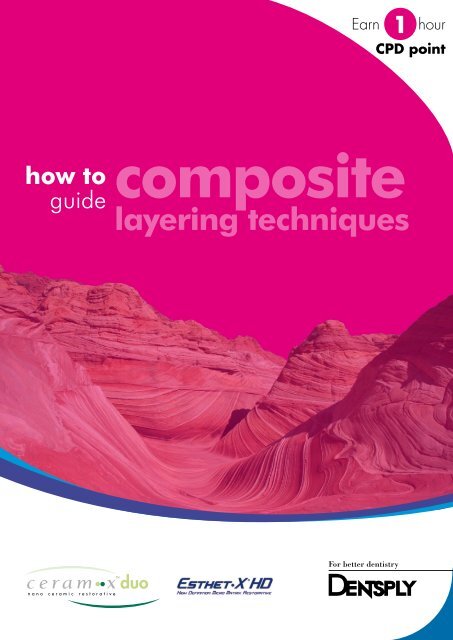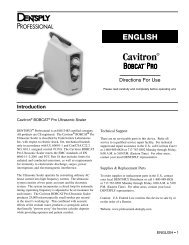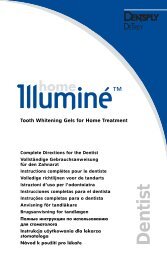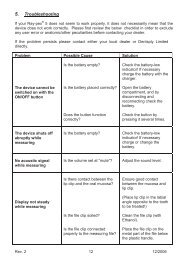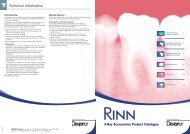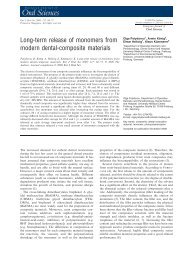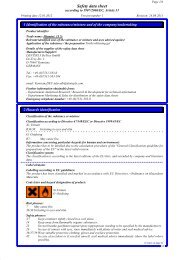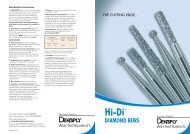Composite & layering techniques - Dentsply
Composite & layering techniques - Dentsply
Composite & layering techniques - Dentsply
Create successful ePaper yourself
Turn your PDF publications into a flip-book with our unique Google optimized e-Paper software.
Earn 1 hour<br />
CPD point<br />
how to<br />
guide<br />
composite<br />
<strong>layering</strong> <strong>techniques</strong>
how to guide<br />
<strong>Composite</strong> & <strong>layering</strong> <strong>techniques</strong><br />
Paul Brunton & Peter J Nixon<br />
Leeds Dental Institute<br />
Resin composite provides the most aesthetic direct restorative<br />
material for restoring teeth. <strong>Composite</strong>s offer the opportunity<br />
for minimal preparation compared to more destructive indirect<br />
alternatives. <strong>Composite</strong> resins are available with a range of optical<br />
characteristics, having a range of translucencies and colours.<br />
Whilst in certain situations, it may be feasible to create an<br />
adequate appearance by using a single composite shade (e.g.<br />
Ceram.X mono), composite systems intended for layered<br />
restorations are now composed of distinct enamel and dentine<br />
shades (e.g. Ceram.X duo, Esthet-X HD). The difference between<br />
the enamel and dentine composite in these materials is marked<br />
with a high opacity and chroma for dentine shades and high<br />
translucency and low chroma for enamel. This difference in optical<br />
characteristics is designed to mimic natural dentine and enamel<br />
and can lead to improved aesthetic integration of restorations.<br />
Introduction:<br />
Esthet-X HD can be successfully used for Class IV, Diastema Closure, Class II & Direct Veneers.<br />
This How to Guide details a Class IV restoration. Please see our website for details on the other<br />
procedures.<br />
Indications for use - Esthet-X HD<br />
Indications for use – Esthet-X HD<br />
1. Esthet-X HD material is indicated as a direct restorative for all cavity classes in anterior and<br />
posterior teeth.<br />
2. Esthet-X HD material is indicated as a direct esthetic veneering material and for cosmetic<br />
reshaping (e.g. diastema closure, incisal lengthening).<br />
3. Esthet-X HD material is indicated for the indirect fabrication of inlays, onlays and veneers.<br />
Contra-indications<br />
If skin sensitisation occurs or if a known allergy to methacrylate resin exists<br />
See DFU’s for Warnings & Precautions<br />
Always read the manufacturer’s full directions for use<br />
In addition to standard cavity preparations, direct composite can<br />
also be used in a number of situations where indirect restorations<br />
have typically been employed. Such indications include;<br />
discolouration / hypoplastic defects, fractured teeth, management<br />
of tooth wear and correction of tooth size / shape discrepancies.<br />
5 Application of the Regular Body<br />
Layer Build up the body shade (up to 2mm)<br />
over the opacious foundation and reproduce<br />
the dentine mamelon form. Feather the Esthet-X<br />
HD restorative onto the enamel bevel. Light<br />
cure for 20 seconds.<br />
6 Application of the Translucent<br />
Enamel Layer Finish the build up of<br />
Esthet-X HD restorative with the Translucent<br />
Enamel Shade (up to 2mm). Feather the<br />
enamel shade over the bevelled enamel<br />
and onto the label surface. Light cure for<br />
20 seconds.<br />
The range of indications for placing direct composite restorations<br />
is increasing as materials improve. When reconciling the<br />
conservation of tooth tissue with the desired outcome of treatment,<br />
direct composite is increasingly becoming the option of choice<br />
ahead of indirect restorations.<br />
Professor Paul Brunton<br />
BChD, MSc, FDS RCS Edin, PhD, FDS (Rest Dent) RCS Edin<br />
Professor of Restorative Dentistry<br />
Indications for use - Ceram.X duo<br />
Direct restorations of all cavity classes in anterior and posterior teeth<br />
Contra-indications<br />
Known allergy to methacrylate resins or any other of the components<br />
See DFU’s for Warnings & Precautions<br />
Peter J Nixon<br />
BChD (Hons), MFDS RCSEd, MDentSci, MFDS (Rest Dent) RCSEd<br />
Specialist in Restorative Dentistry, Prosthodontics, Periodontics and<br />
Endodontics Consultant in Restorative Dentistry<br />
Always read the manufacturer’s full directions for use<br />
Objectives<br />
Upon completion of this guide, the clinician will be able to do the<br />
following:<br />
A Appreciate the reason for using a <strong>layering</strong> technique for direct<br />
restorations<br />
B Understand the benefits of Ceram.X duo and Esthet-X HD<br />
C Learn more about the two and three layer technique<br />
D Understand the range of composite materials available<br />
40 sec*<br />
5 Light-cure dentine layer<br />
*Light output ≥ 500mW/cm2 only.<br />
6 Restore enamel layer<br />
with duo enamel shade.
Why use a <strong>layering</strong> technique?<br />
Both colour (shade) and translucency (contrast ratio) determine<br />
the aesthetic quality of a composite restoration. Colour is<br />
important because the shade match between the restoration<br />
and its surrounding teeth must be indistinguishable.<br />
Translucency of a restorative will provide the added “life-like”<br />
vitality and natural appearance of the completed restoration.<br />
Translucency may be measured as contrast ratio, wherein a<br />
material becomes less translucent (more opaque) as the contrast<br />
ratio increases. Custom blending of differing opacities allows<br />
the clinician to create restorations possessing natural aesthetic<br />
beauty; giving the patient the best possible result.<br />
Esthet-X HD<br />
1 Shade Selection Select the shade tab from<br />
the Esthet-X HD TruMatch Shade Guide that<br />
matches the patient’s natural dentition. Refer<br />
to the back of the Shade Guide Holder or to<br />
the silver shade tab to review the composite<br />
selection (“recipe”) used to create the shade<br />
tab. The Opacious Dentine Shades will<br />
block out the darkness of the mouth in a Class<br />
IV restoration. The Regular Body Shades will<br />
provide the lifelike translucence and color to the<br />
resoration. The Translucent Enamel Shades will<br />
create natural-looking incisal edges.<br />
2 Preparation and Etch Create a<br />
bevelled preparation, preserving the enamel<br />
at the gingival margin (30° to 45°, 3mm<br />
average). Condition the enamel for at least<br />
15 seconds and dentine for 15 seconds<br />
or less. Rinse conditioned areas for 10<br />
seconds. Blot dry but do not desiccate the<br />
dentine; keep moist.<br />
3 Bonding Apply Prime&Bond ® NT<br />
Adhesive to the preparation and saturate all<br />
surfaces for at least 20 seconds. Remove<br />
excess solvent by gently air drying for 5<br />
seconds. Surfaces should have a uniform,<br />
glossy appearance. Light cure for 10<br />
seconds. If not glossy, repeat steps 3A<br />
and 3B.<br />
other proceedures<br />
4 Application of the Opacious<br />
Dentine Layer Apply the Opacious<br />
Dentine Shade increment (up to 2mm).<br />
Feather material to the bevel.<br />
Light Cure for 20 seconds.<br />
Diastema Closure<br />
Class II<br />
before after before after<br />
7 Finishing A. Define the final anatomy with a<br />
multi-fluted finishing bur or a diamond finishing<br />
bur. B. Continue to finish with Enhance ® Discs,<br />
Cups or Points. Lighter pressure leaves a<br />
smooth surface.<br />
8 Polishing For a glass like luster, polish<br />
the restoration with the PoGo ® One Step<br />
Diamond Micro-Polisher System and/or<br />
Prisma ® Gloss Polishing Pastes.<br />
Direct Veneer<br />
Please visit<br />
www.dentsply.co.uk<br />
for further information<br />
before<br />
after<br />
Ceram.X duo<br />
or<br />
or<br />
1 Use the Vita-Shadeguide<br />
and shade label.<br />
2 …or the Ceram.X shadefingers. 3 Select Adhesive,<br />
please consult directions.<br />
4 Restore dentine core with<br />
duo dentine shade.<br />
10 sec*<br />
before<br />
after<br />
7 Light-cure enamel layer<br />
*Light output ≥ 500mW/cm2 only.<br />
8 Shade and contour. 9 Finish and polish with Enhance ® Discs,<br />
Cups or Points and PoGo ® One-Step<br />
Micro-Polisher System.
Earn one hour CPD point…<br />
To receive your CPD certificate, please email your answers to the questions below to: marketing.weybridge@dentsply-gb.com.<br />
Visit www.dentsply.co.uk to complete your answers online.<br />
1. How many types of restoration<br />
detailed in this brochure can Esthet.X<br />
HD be used for?<br />
A Two B Three<br />
C Four D Five<br />
2. How thick should the application of<br />
the Opacious Dentine Layer be?<br />
A Up to 2mm<br />
B<br />
C<br />
Up to 3mm<br />
Up to 4mm<br />
D Up to 5mm<br />
3. How long should the translucent<br />
enamel layer be light cured for?<br />
A 10 seconds B 20 seconds<br />
C 30 seconds D 60 seconds<br />
4. Which of the following DENTSPLY<br />
products could be used for Finishing &<br />
Polishing?<br />
A Illuminé B Spectrum<br />
C PoGo ® D Xeno ® V<br />
5. As the contrast ratio increases,<br />
does a material become more or<br />
less translucent?<br />
A More translucent<br />
B Less translucent<br />
6. What is the first step in a composite<br />
restoration<br />
A Preparation & Etch<br />
B<br />
C<br />
Bonding<br />
Polishing<br />
D Shade selection<br />
7. Which of the following composite uses<br />
a single layer technique?<br />
A Ceram.X ® mono<br />
B<br />
C<br />
Ceram.X ® duo<br />
Esthet.X HD<br />
D None of the above<br />
8. Direct composites can also be used in<br />
a number of situations where indirect<br />
restorations have been typically used.<br />
This includes:<br />
A Discoloration B Fractured Teeth<br />
C Tooth Wear D All of the above<br />
9. Which comes first – restoration of<br />
the dentine core or restoration of the<br />
enamel layer?<br />
A The Dentine Core B<br />
The Enamel Layer<br />
10. When using Ceram.X duo, how long<br />
should the enamel layer be light<br />
cured for?<br />
A 5 seconds B 10 seconds<br />
C 15 seconds D 20 seconds<br />
Reader Feedback<br />
We encourage your comments<br />
on this “How to Guide”. Please email<br />
any comments or suggestion on how to<br />
improve this guide to<br />
marketing.weybridge@dentsply-gb.com<br />
Other How to Guides available:<br />
scaling<br />
how to guide<br />
& root planing<br />
Earn 1 hour<br />
CPD point<br />
Earn 1 hour<br />
CPD point<br />
how to<br />
guide whitening<br />
air<br />
polishing<br />
air<br />
how to<br />
guide<br />
Earn 1 hour<br />
CPD point<br />
Scaling &<br />
root planing<br />
Whitening<br />
Air polishing<br />
UKP00175<br />
For more information, on the products please detailed call our in this freephone How to Guide, number please or call email our freephone us: number or email us:<br />
+44 (0)800 072 3313 enquiry@dentsply-gb.com<br />
www.dentsply.co.uk www.dentsply.com


